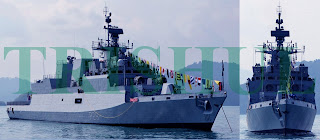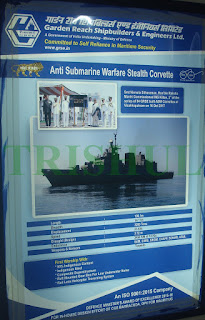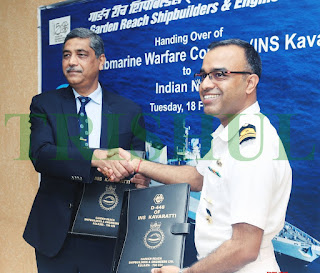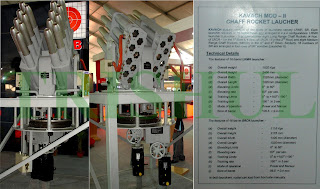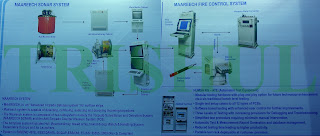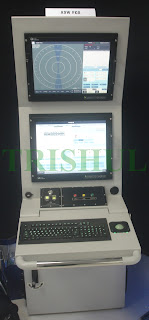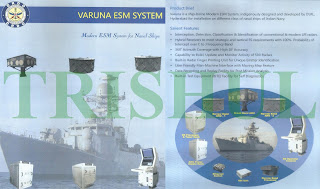While indigenisation of the design, development and construction of naval principal surface combatants is a laudable objective, it is the apex-level project management of successive warship construction projects that has consistently, since the late 1990s, serve to sabotage the laudatory objectives, with no tangible changes being expected for future domestic warship construction projects as well. For instance, the cost escalation has been about 225% for the three Project 15A guided-missile destroyers (DDG), about 260% for the three Project 17 guided-missile frigates (FFG), and about 157% for the four Project 28 guided-missile corvettes, each of which is likely to cost $435 million.
In fact, the project cost of these four anti-submarine warfare (ASW) corvettes has inflated from a sanctioned amount Rs.28 billion or $560 million (Rs.7 billion or $140 million per 2,500-tonne vessel) to an estimated Rs.70 billion ($1.4 billion) now. Similar estimations are now doing the rounds on the projected four 6,800-tonne Project 15B DDGs (approved by the MoD’s Defence Acquisitions Council in February 2009).
Two principal reasons are to blame for such a sad state of affairs: the inability of the Indian Navy’s (IN) in-house Directorate of Naval Design’s (DND) Naval Design Bureau (NDB) to freeze a warship’s design prior to the commencement of metal-cutting for hull construction; and the failure of the Ministry of Defence’s (MoD) bureaucracy to synchronise the warship construction schedules with other Ministries responsible for supplying raw materials like specialised steel and on-board other sub-systems—both of which are procured from either public-sector undertakings like the Steel Authority of India Ltd (SAIL) or defence public-sector undertakings (DPSU). Instead, the ones who are almost everytime blamed for the delayed warship deliveries are the MoD-owned DPSUs like the shipbuilding yards.
Take, for instance, the delivery schedule of the fourth Project 28 ASW guided-missile corvette—INS Kavaratti P-31, which was handed over by the MoD-owned, Kolkata-based Garden Reach Shipbuilders & Engineers Ltd (GRSE) to the IN on February 18, 2020. This corvette’s keel-laying had taken place on January 20, 2012, followed by hull-launch on May 19, 2015. Yet, it took more than five years for this vessels to be service-inducted (on October 22, 2020).
The first three in the series, INS Kamorta P-28 (whose metal-cutting began on March 1, 2006; keel-laying took place on November 20, 2006; the hull was launched on April 19, 2010; her maiden sea-trial took place in June 2013; was handed over to the IN on July 12, 2014; and she was commissioned on August 23, 2014), INS Kadmatt P-29 (keel-laying on September 27, 2007; hull-launching on October 25, 2011; and commissioned on January 7, 2016) and INS Kiltan P-30 (keel-laying on August 10, 2010; hull-launch on March 26, 2013 and commissioned on October 16, 2017) took between seven and nine years to be delivered. The principal reason for such delayed deliveries was a critical miscalculation by the DND of the warship design’s displacement and weight, which had led to the first three corvettes becoming top-heavy and consequently a laborious and time-consuming weight-shedding effort had to be carried out by GRSE.
For the INS Kavaratti, the NDB decided to make extensive use of composites-based sub-structures, especially in the mast section, in order to reduce weight and for this both fabrication expertise and raw materials supplies were sought and obtained from Sweden’s Kockums AB. In addition, other weight-reduction measures adopted included doing away with the French SAMAHE rail-based helicopter traverse system and instead, adopting a wire-based system known as Rail-Less Helo-Traversing System. GRSE has a licenced production agreement for a period of 10 years with UK-based Mac Teggart, Scott & Co Ltd for fabricating such Rail-Less Helo-Traversing System. Also, the concept of foldable hanger-doors developed by Larsen & Toubro was adopted for the helicopter deck, thereby doing away with rolling hanger-doors.
Earlier, back in 2003, the IN had planned on using Russia-origin D40S/B-quality high tensile strength steel for construction of the four corvettes. However, due to the high cost of import, indigenously developed DMR-249A special grade high-tensile steel was decided to be used. However, due to mis-communication between the MoD and the Department of Heavy Industries, there was delay in the bulk production of indigenous steel (by SAIL) and associated complexities related to the development of new weld-consumables and welding techniques (by MIDHANI). Finally, the delay in identification of a suitable propulsion package by the NDB to meet the stealth requirement of the corvettes, and delays in the development of indigenous weapons and sensors by the MoD-owned defence R & D Organisation (DRDO) also resulted in cost escalation.
The ASW corvette incorporates a state-of-art low-noise CODAD (combined diesel and diesel) propulsion system with hydraulic coupling between main engines and gearbox. Engines used are four Pielstick 12 PA6 STC diesel engines, each with a power of 5,096hp (3,800kW). France’s Naval Group entered into a contract with the GRSE encompassing the delivery of four shipsets of raft-mounted gearboxes with stealth features (total of eight gearboxes), machinery system integration expertise for the whole propulsion system, technical assistance to GRSE for integration of the gearboxes and all related warship-trials, and licencing Walchandnagar Industries Ltd (WIL) for manufacturing the gearboxes under a transfer-of-technology package. On each corvette, two controllable-pitch propellers driven by the two raft-mounted gearboxes are capable of twin output or single output as required. A DRDO-developed infra-red signature suppression system is fitted in the engine exhausts for reducing infra-red signatures.
Each corvette also comes fitted with a Larsen & Toubro-built stabilisation system, a reverse-osmosis plant for freshwater generation, sewage treatment plant with vacuum toilet facilities that are totally compliant with International Maritime Organisation regulations, and an operator friendly Total Atmospheric Control System for high combat readiness with improved habitability and features a fully air-conditioned modular type accommodation. Electrical generation comes from four diesel-engine sets each producing 3mWe, thereby ensuring 100% redundancy at all times. Also on board are indigenously-developed Integrated Platform Management System and an Integrated Bridge System.
However, all four Project ASW corvettes have entered naval service in sub-optimal configuration, since none of them as yet have neither the ATLAS Elektronik-developed ACTAS active/passive towed-array sonar suite, nor the SR-SAM SHORADS for self-defence.
Consequently, at best only 70% material content can be claimed as being indigenous for each of the four corvettes.
The Predecessors
The IN’s previous ASW-specific warships were the 10 Project 159AE Storozhevoi Korabl vessels that were built in successive tranches by the USSR’s Khabarovsky Shipyard in the Far East between 1968 and 1974 and equipped with IN’s 31 Patrol Vessel Squadron of the Eastern Naval Command and the 32 Patrol Vessel Squadron of the Western Naval Command. The first tranche comprised the INS Kamorta P-77 (commissioned on November 21, 1968 and decommissioned on October 31, 1991), INS Kadmatt P-78 (commissioned on December 23, 1968 and decommissioned on November 30, 1992), INS Kiltan P-79 (commissioned on October 30, 1969 and decommissioned on June 30, 1987), INS Katchall P-81 (commissioned on December 23, 1969 and decommissioned on December 31, 1988), and INS Kavaratti P-80 (commissioned on December 23, 1969 and decommissioned on July 31, 1986). The second tranche was built at Shipyard No.820 in Kaliningrad (Baltisky Zavod, now Yantar Shipyard) and comprised the INS Arnala P-68 (commissioned on June 29, 1972 and decommissioned on April 9, 1999), INS Androth P-69 (commissioned on June 30, 1972 and decommissioned on April 9, 1999), INS Anjadip P-73 (commissioned on December 23, 1972 and decommissioned on December 13, 2003, INS Amini P-75 (commissioned on December 12, 1974 and decommissioned on September 16, 2002) and INS Andaman P-74 (commissioned on December 28, 1973, and was lost at sea in storm conditions 230km east of Visakhapatnam on August 21, 1990).
Crew: 106.
Standard Displacement: 970 tonnes.
Full-Load Displacement: 1,110 tonnes.
Length: 82.3 metres.
Beamwidth: 9.2 metres.
Draught: 2.89 metres.
Maximum Speed: 32 Knots.
Range: 2,000nm at 14 Knots cruise speed, 1,500nm at 16,5 Knots, 800nm at 18 Knots.
Endurance at Sea: 10 days.
Propulsion: 2 x 15,000hp M-2B gas-turbines, 1 x 6,000hp Type-61B diesel engine, 1 x diesel-generator rated at 400kW, 1 x diesel-generator rated at 200kW, 1 x diesel-generator rated at 100kW.
Armament: 2 x 2 AK-726 76mm turret-mounted naval guns using the Fut-B fire-control system, 2 x 5 PTA-40-159 400mm torpedo tubes (10 SET-40 torpedoes carried on-board), 2 x 12 RBU-6000 Smerch-2 (RGB-60) ASW mortar launchers using the Burya fire-control system, and 22 mines.
Electronics: MR-302 Rubka radar, Bizan`-4B ESM suite, Don navigation radar, MG-312 Titan and MG-311 Vychegda sonar suites.

